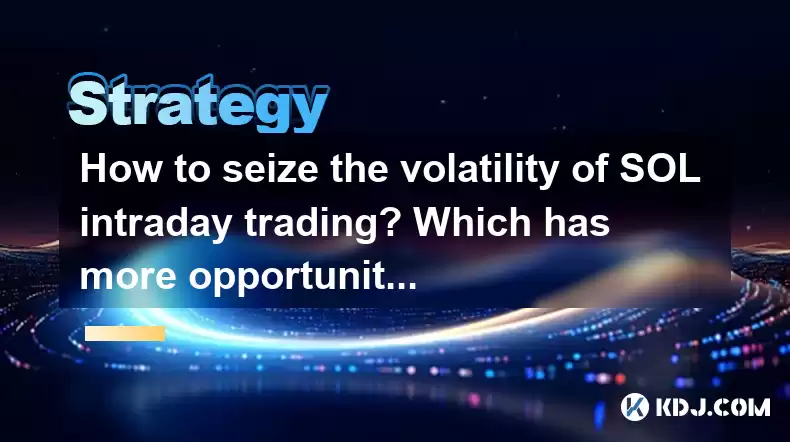-
 bitcoin
bitcoin $107208.295278 USD
-1.54% -
 ethereum
ethereum $3874.629914 USD
-1.38% -
 tether
tether $1.000440 USD
0.03% -
 bnb
bnb $1089.465513 USD
-5.53% -
 xrp
xrp $2.327672 USD
-1.65% -
 solana
solana $184.766505 USD
-0.73% -
 usd-coin
usd-coin $1.000076 USD
0.02% -
 tron
tron $0.310632 USD
-1.99% -
 dogecoin
dogecoin $0.187615 USD
-1.60% -
 cardano
cardano $0.633389 USD
-2.75% -
 ethena-usde
ethena-usde $0.999553 USD
0.03% -
 hyperliquid
hyperliquid $35.608231 USD
-4.13% -
 chainlink
chainlink $16.876114 USD
-3.98% -
 stellar
stellar $0.312239 USD
-0.91% -
 bitcoin-cash
bitcoin-cash $473.262969 USD
-7.09%
How to seize the volatility of SOL intraday trading? Which has more opportunities in the early trading or the late trading?
Seize SOL's intraday volatility with scalping, momentum, and breakout strategies; early trading offers higher volatility and liquidity, while late trading provides consolidation opportunities.
Apr 29, 2025 at 05:00 pm

Intraday trading of cryptocurrencies like Solana (SOL) can be a lucrative endeavor due to the high volatility and potential for quick profits. However, it requires a solid understanding of market dynamics, effective strategies, and careful timing. In this article, we will explore how to seize the volatility of SOL through intraday trading and determine whether early or late trading offers more opportunities.
Understanding SOL Volatility
SOL, like many cryptocurrencies, experiences significant price fluctuations within a single trading day. These fluctuations are influenced by various factors, including market sentiment, news events, and trading volumes. Understanding these factors is crucial for intraday traders looking to capitalize on SOL's volatility.
To effectively trade SOL intraday, traders need to monitor real-time data and use technical analysis tools. Technical indicators such as moving averages, Relative Strength Index (RSI), and Bollinger Bands can help identify potential entry and exit points. Additionally, staying updated with market news and social media trends can provide insights into sudden price movements.
Strategies for Seizing SOL Volatility
There are several strategies that traders can employ to take advantage of SOL's intraday volatility. Here are some of the most effective ones:
Scalping: This strategy involves making numerous small trades throughout the day to profit from minor price changes. Scalpers aim to capture small profits from each trade, which can add up over time. To scalp SOL effectively, traders need to be highly attentive to market movements and have a quick decision-making process.
Momentum Trading: Momentum traders look for stocks or cryptocurrencies that are moving significantly in one direction on high volume. They enter trades in the direction of the trend and aim to exit before the trend reverses. For SOL, momentum trading can be particularly effective during periods of high volatility.
Breakout Trading: This strategy involves identifying key levels of support and resistance and entering trades when the price breaks out of these levels. Breakout traders can use tools like trend lines and chart patterns to identify potential breakouts in SOL's price.
Early Trading vs. Late Trading: Which Offers More Opportunities?
The timing of your trades can significantly impact your success in intraday trading. Let's compare the opportunities available during early trading and late trading for SOL.
Early Trading Opportunities
Early trading typically refers to the first few hours after the market opens. During this time, there is often a surge in trading volume as traders react to overnight news and events. This can lead to increased volatility, providing ample opportunities for intraday traders.
Higher Volatility: The early hours of trading often see higher volatility as the market digests new information. This can create more opportunities for traders to capitalize on price movements.
Liquidity: Early trading tends to have higher liquidity, making it easier to enter and exit positions without significantly impacting the price.
Trend Formation: Many trends start to form in the early hours of trading. Identifying these trends early can provide a significant advantage for intraday traders.
Late Trading Opportunities
Late trading refers to the last few hours before the market closes. While the volume may be lower compared to the early hours, there are still opportunities to be found.
Consolidation: Late trading often sees the market consolidating after the day's major moves. This can provide opportunities for traders to enter positions at more favorable prices.
News Impact: Late trading can be influenced by news released during the day. Traders can capitalize on these late-breaking developments to make profitable trades.
Position Squaring: As the trading day nears its end, many traders will square their positions, leading to increased volatility. This can create opportunities for intraday traders to profit from these last-minute movements.
Practical Steps for Intraday Trading SOL
To effectively seize the volatility of SOL through intraday trading, follow these practical steps:
Choose a Reliable Exchange: Select a reputable cryptocurrency exchange that offers SOL trading pairs. Ensure the exchange has a user-friendly interface and robust security measures.
Set Up Your Trading Account: Register for an account on the chosen exchange. Complete the necessary verification processes and deposit funds into your account.
Use Trading Tools: Utilize trading tools and platforms that offer real-time data, technical analysis indicators, and charting capabilities. Platforms like TradingView or the exchange's own trading interface can be useful.
Develop a Trading Plan: Create a detailed trading plan that outlines your entry and exit strategies, risk management rules, and profit targets. Stick to your plan to avoid emotional trading decisions.
Monitor Market Conditions: Keep an eye on market conditions, including trading volumes, price movements, and news events. Use this information to make informed trading decisions.
Execute Trades: Based on your analysis and trading plan, execute your trades. Use limit orders to enter and exit positions at specific price levels.
Review and Adjust: After each trading session, review your performance and adjust your strategy as needed. Continuous learning and adaptation are key to success in intraday trading.
Early Trading vs. Late Trading: A Detailed Comparison
To further understand which part of the trading day offers more opportunities for SOL intraday trading, let's delve into a detailed comparison of early and late trading.
Volatility Levels: Early trading often experiences higher volatility due to the reaction to overnight news and events. This can lead to more significant price movements, providing more opportunities for traders. In contrast, late trading may see lower volatility as the market consolidates, but there can still be opportunities from late-breaking news and position squaring.
Liquidity: Early trading typically has higher liquidity, making it easier to enter and exit positions. This can be advantageous for traders looking to capitalize on quick price movements. Late trading may have lower liquidity, which can make it more challenging to execute trades without impacting the price.
Trend Identification: Trends often start to form in the early hours of trading. Identifying these trends early can provide a significant advantage for intraday traders. Late trading may see trends consolidating or reversing, which can also provide trading opportunities but may require different strategies.
News Impact: Both early and late trading can be influenced by news events. Early trading reacts to overnight news, while late trading can be affected by news released during the day. Traders need to stay informed and adapt their strategies accordingly.
FAQs
Q: How can I manage risk while trading SOL intraday?A: Risk management is crucial in intraday trading. Use stop-loss orders to limit potential losses, and never risk more than a small percentage of your trading capital on a single trade. Additionally, diversify your trades and avoid over-leveraging to manage risk effectively.
Q: What are the best technical indicators for trading SOL intraday?A: Some of the best technical indicators for trading SOL intraday include the Moving Average Convergence Divergence (MACD), the Relative Strength Index (RSI), and Bollinger Bands. These indicators can help identify trends, momentum, and potential reversal points.
Q: How important is it to stay updated with news while trading SOL intraday?A: Staying updated with news is extremely important for intraday trading. News events can significantly impact the price of SOL, and being aware of these events can help you make informed trading decisions. Use reliable news sources and set up alerts for important announcements.
Q: Can I use automated trading bots for SOL intraday trading?A: Yes, automated trading bots can be used for SOL intraday trading. These bots can execute trades based on predefined criteria and can help you take advantage of market opportunities 24/7. However, it's essential to thoroughly test and monitor your bots to ensure they perform as expected.
Disclaimer:info@kdj.com
The information provided is not trading advice. kdj.com does not assume any responsibility for any investments made based on the information provided in this article. Cryptocurrencies are highly volatile and it is highly recommended that you invest with caution after thorough research!
If you believe that the content used on this website infringes your copyright, please contact us immediately (info@kdj.com) and we will delete it promptly.
- Pi Network, Binance, and the Strategic Delay: A New York State of Mind
- 2025-10-18 14:45:15
- Crypto Presale Mania: MoonBull, Ethereum, and Bitcoin in the Spotlight
- 2025-10-18 15:05:15
- Ondo Finance, Nasdaq, and Transparency: A Call for Open Standards in Tokenized Securities
- 2025-10-18 14:45:15
- OriginTrail, TRAC, and the Convergence Chapter: Navigating Trust in the Age of AI
- 2025-10-18 14:25:15
- Firefighter, Fire Engine, Driving Skills: Vancouver's Innovative Approach
- 2025-10-18 14:25:15
- FIFA, NFTs, and Legal Action: A Risky Game?
- 2025-10-18 12:45:14
Related knowledge

Practical parameter settings for a Bitcoin multi-timeframe moving average system
Sep 18,2025 at 10:54pm
Optimizing Timeframe Combinations for Bitcoin Trading1. Selecting appropriate timeframes is crucial when building a multi-timeframe moving average sys...

How can I filter out false breakouts in Dogecoin high-frequency trading?
Sep 22,2025 at 01:00am
Understanding False Breakouts in Dogecoin Trading1. A false breakout occurs when Dogecoin's price appears to move beyond a defined support or resistan...

Techniques for identifying tops and bottoms in the Bitcoin on-chain NVT model
Sep 20,2025 at 07:54pm
Understanding the NVT Model in Bitcoin Analysis1. The Network Value to Transactions (NVT) ratio is often described as the 'P/E ratio' of the cryptocur...

What does the surge in open interest in Bitcoincoin futures mean?
Sep 20,2025 at 11:18pm
Understanding the Surge in Dogecoin Futures Open Interest1. A surge in open interest within Dogecoin futures indicates a growing number of active cont...

How can I use the Ethereum USDT premium to gauge market sentiment?
Sep 18,2025 at 11:55pm
Understanding the Ethereum USDT Premium1. The Ethereum USDT premium refers to the price difference between USDT (Tether) traded on Ethereum-based plat...

What should I do if Ethereum staking yields decline?
Sep 20,2025 at 06:18am
Understanding the Causes Behind Declining Ethereum Staking Yields1. The Ethereum network transitioned to a proof-of-stake consensus mechanism with the...

Practical parameter settings for a Bitcoin multi-timeframe moving average system
Sep 18,2025 at 10:54pm
Optimizing Timeframe Combinations for Bitcoin Trading1. Selecting appropriate timeframes is crucial when building a multi-timeframe moving average sys...

How can I filter out false breakouts in Dogecoin high-frequency trading?
Sep 22,2025 at 01:00am
Understanding False Breakouts in Dogecoin Trading1. A false breakout occurs when Dogecoin's price appears to move beyond a defined support or resistan...

Techniques for identifying tops and bottoms in the Bitcoin on-chain NVT model
Sep 20,2025 at 07:54pm
Understanding the NVT Model in Bitcoin Analysis1. The Network Value to Transactions (NVT) ratio is often described as the 'P/E ratio' of the cryptocur...

What does the surge in open interest in Bitcoincoin futures mean?
Sep 20,2025 at 11:18pm
Understanding the Surge in Dogecoin Futures Open Interest1. A surge in open interest within Dogecoin futures indicates a growing number of active cont...

How can I use the Ethereum USDT premium to gauge market sentiment?
Sep 18,2025 at 11:55pm
Understanding the Ethereum USDT Premium1. The Ethereum USDT premium refers to the price difference between USDT (Tether) traded on Ethereum-based plat...

What should I do if Ethereum staking yields decline?
Sep 20,2025 at 06:18am
Understanding the Causes Behind Declining Ethereum Staking Yields1. The Ethereum network transitioned to a proof-of-stake consensus mechanism with the...
See all articles























![[4K 60fps] 5upreme by RoyalP (1 coin) [4K 60fps] 5upreme by RoyalP (1 coin)](/uploads/2025/10/18/cryptocurrencies-news/videos/k-fps-upreme-royalp-coin/68f2e6c9ef491_image_500_375.webp)


















































